Entries in Wind farm construction (20)
8/19/10 Wind farms and wildlife, What to expect when you're expecting wind farm construction, and what's the big deal about shadow flicker? AND Wisconsin in two years time: A look at what wind siting reform has done to the state of Maine
Wind farms and wildlife: The heartbreak of the Horicon
Wind farms and Bats:
How are bats being killed in wind farms?
WIND FARM CONSTRUCTION VIDEOS
Video of what kind of changes a wind turbine brings to a farmer's fields.
Trenching and electrical cables
Access roads and soil disturbance
Torn up roads and compacted soil
Heavy equipment and cranes compact soil
How big are the shadows cast by industrial scale turbines? What do they look like? Why are they a problem?
What is shadow flicker like on houses in Wisconsin wind projects?
SECOND FEATURE
RESIDENTS SAY STATE RULES FOR WIND FARMS LACKING
SOURCE: Sun Journal, www.sunjournal.com
August 19 2010
By Eileen M. Adams
DIXFIELD — Panelists and townspeople at a public hearing Wednesday night blasted what they believe are insufficient state regulations to govern the half-dozen or so wind farms proposed for western Maine.
The hearing was sponsored by the River Valley Alliance and the Friends of Maine’s Mountains, groups that oppose such developments. Other groups, such as the Friends of Spruce Mountain in Woodstock, were also at the hearing.
Among the panelists was Robert Rand, an acoustical engineer from Brunswick, who described the potential effects on people of the sounds made by the blades and generators of turbines.
During much of his talk, he played a recording of a turbine operation he said was made at a small operation in Freedom.
Such noise, he said, has the potential to adversely affect people living as close as 2 miles from an operating turbine. He said the frequency and decibel levels could result in the inability to sleep, high blood pressure and other maladies.
Paul Druan, chairman of the Weld Windpower Committee that is charged with developing a wind farm ordinance, said that when he attended a similar forum with the sound of turbines turning, one man became nauseated.
Sean DuBois, whose residence was not immediately available, said he believed more studies should be conducted on the possible adverse health effects.
“Don’t you think it’s too early to judge health effects?” he said.
Rand said he didn’t think so.
“There are people in Mars Hill, Freedom and an island on the coast who definitely have problems,” he said. “I’m concerned about the lack of peer-reviewed studies by the companies.”
He said that sounds from turning turbines do not decrease as quickly over water as they do over land.
A home should not be located less than 2 miles from a turbine, and even then, the sounds could affect people, he said.
Also speaking was Karen Pease, a resident of Lexington Township which is next to the state’s largest proposed wind turbine project in Highland Plantation. Independence Wind LLC, whose principals are former Gov. Angus King and Rob Gardiner, have proposed construction of 48 turbines.
She spoke of the effect the siting of wind turbines could have on real estate. She said Maine doesn’t have a sufficient number of houses on the market to do comparable studies, but one done in Illinois showed at least a 25 to 40 percent drop in value for homes about 2 miles from a wind project.
“Some are a total loss,” she said.
Also, she said, wind developers are not being required to provide a bond for decommissioning turbines so that they could be taken down and the land reclaimed.
Dan McKay, a major player in the organization of the hearing, said that with the number of people who live in the River Valley area, building what he estimated to be about 100 turbines made little sense.
“Turbines are a chance to shut down the recreational opportunities in the area,” he said.
Nearly 200 proposed turbines are in various stages of development from the Rumford area to Highland Plantation. First Wind LLC of Newton, Mass., has proposed siting up to 19 turbines in Rumford and Roxbury; Independent Wind LLC is proposing the Highland Plantation project and 22 turbines in Roxbury; and Patriot Renewables LLC of Quincy, Mass., has proposed a total of about 50 turbines in Carthage, Dixfield, Canton and Woodstock.
McKay said signatures were being gathered on a petition asking the Maine Department of Environmental Protection to change the acceptable decibel level produced by turbines to 5 decibels above the ambient level in an area currently without turbines.
He said the signatures collected in several River Valley towns and Woodstock would be sent to the Citizens Task Force, which is circulating a petition statewide calling for more regulations on wind development.
7/26/10 TRIPLE FEATURE: From open arms to balled up fists: Wisconsin resident comments on living in a wind project under construction AND Why he left the family farm: Wisconsin resident lays out his first-hand experience with wind development. The majority of the Wind Siting Council looks the other way
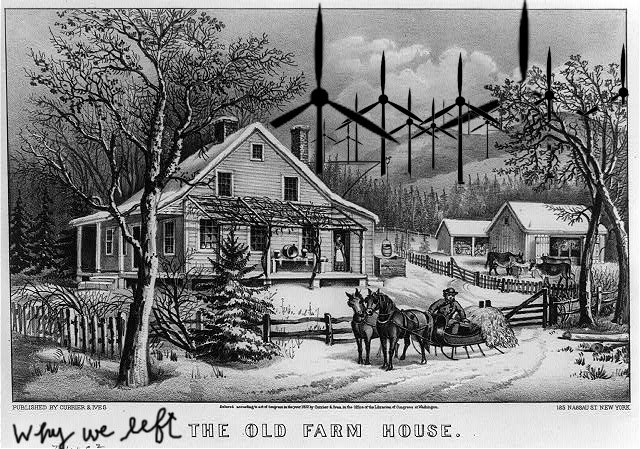
PUBLIC COMMENT TO PUBLIC SERVICE COMMISSION FROM RESIDENT OF PSC APPROVED GLACIER HILLS PROJECT CURRENTLY UNDER CONSTRUCTION:
To the landowners in the Ledge Wind Project:
If you believe wind turbines are a good fit for a farm operation, a free source of clean energy, and a benefit to your community, I invite you to come to the Glacier Hills Project and witness the total devastation occuring during construction.
Seeing firsthand what is happening here would turn any responsible landowner's stomach.
Heavy rains have created erosion that will take years to repair.
The number of huge construction equipment and trucks burning fuel is staggering.
Good productive farmland is being ripped apart, and will never be the same.
The level of disgust is even affecting the most loyal supporters of this project.
Hatred of this project is growing worse as each day passes, and we will be forced to live with this for the rest of our lives, all because a few irresponsible landowners, myself included, were taken in by wind developers lies.
All this for chump change.
I affirm that these comments are true and correct to the best of my knowledge and belief.
Gary Steinich
Cambria, WI
SECOND FEATURE
TESTIMONY
Comments submitted by Wisconsin resident, Joe Yunk, to the Public Service Commission of Wisconsin, July 2010
My name is Joe Yunk; I currently reside at the address of N2630 Townhall Rd in Kewaunee County.
My prior address was North 7905 County Trunk P, Algoma, Wisconsin which was in the Wisconsin Public Service (WPS) wind farm by Rio Creek, Wisconsin. I moved from the Algoma address to my current address on or about October 2009 to get away from the effects of the WPS wind farm.
I have been following the current proposed Element Power LLC (EEP) wind farm development that I now find myself living in.
I want you to know what I went through while living in the WPS wind farm. I am hopeful that this information will help you make the right decisions with regard to any PSCW approvals for any other wind farms in Wisconsin.
I would hate to see other peoples’ lives to be as negatively affected as mine has been as a result of living in a wind farm. There is no doubt in my mind that I will relive the awful experience once again if the EEP wind farm for Kewaunee County is approved.
In 1998 the WPS wind farm construction began about 300 yards from my home. I had built this home in 1980 on 6.5 acres of land which was our home farm that I lived on all my life. I was born on November 28, 1954. I had two turbines within one-half mile, one of those turbines was about 1,300 ft from my house and 600 ft from my property line.
In the summer of 2000, the turbines of the WPS wind farm began operation. Inasmuch as I had lived on this farm all my life, I knew the neighbors well, and it wasn’t long after the turbines began operating our lives began to change.
In conversations with my neighbors, I learned, they too were experiencing constant disturbing noise, shadow flicker and just the constant presence of the turbines. By presence I felt uneasy and irritated by the size and closeness of these 220 ft. turbines.
All the people living in this wind farm were guinea pigs/lab rats, no one knew what we were in for. It was in the fall of 2000 when neighbors and families began to divide over the effects of the wind farm. And that continued throughout the time I lived there.
When the turbines began to operate, a hotline was established directly to WPS to report any problems.
I had beef cattle for about two years prior to the turbines operating and never lost any animals. However, shortly after the turbines began to operate, I had beef cattle become ill and die. I reported this on the WPS hotline and nothing was done. I lost ten animals valued at $5,000 [each] over a two year period and couldn’t afford to continue.
Because of noise complaints to WPS, within a year, two families’ homes were purchased by WPS and demolished.
Additionally, at the same time WPS was settling nuisance suits with other neighbors. They were offering to buy out my neighbors but offered prices way below market value to stop the complaints.
However, they never offered me any buyout opportunity and I wanted out! It was hard for me to leave my home place of 54 years. Over time, however, living with the constant sleep deprivation and irritation of the noise and flickering I decided to sue WPS to have them pay me fair market value for my home so I could afford to move.
I knew that I might be risking everything I had worked for all my life, but I didn’t care at this point. I didn’t even try to sell my place outright because I didn’t want anyone else to have to live as I did in this wind farm. I really wanted WPS to buy me out and to demolish the home.
I retained an attorney and filed suit with WPS. Shortly after, WPS offered me $110,000 on my property that appraised for $168,000. I decided not to take their offer, but proceed with the suit.
I gave deposition in the summer of 2008, we were scheduled to go trail in September 2009 and WPS offered me a settlement in August of 2009 for $163,000. With this settlement I was responsible for my attorney fees. My attorney advised me to accept this offer. After paying my attorney fees, I ended up with $158,000.
Later, my home and property were listed with a real estate agency for sale by WPS for 30% below the appraised value.
From my experience in living in this wind farm, it is apparent that setback away from property lines is absolutely necessary. I could hear the turbines a mile away from my house. The PSCW’s standard setback from a property line should be 1.5 miles.
Now, my new home and property on Townhall road is within the confines of the EPP proposed wind farm. I`d like to know what you recommend I do now?
WIND TURBINES IN THE NEWS:
Annie Hart Cool of Falmouth said a turbine was erected within 1,500-feet of her home and has disrupted her husband’s sleep so severely he’d forced to sleep in the basement. He is an air-traffic controller, she added, and can’t afford to lose sleep. And the turbine is absolutely adversely impacting property values, she said.
“Wind turbines are like living next to a train or a dump,” Cool said. “These are realities, I’m a real person and this is really happening to me.”
SOURCE: State House News Service, www.wickedlocal.com
12/29/07 Fond Du Lac Farmer Asks, "What Have I Done?"
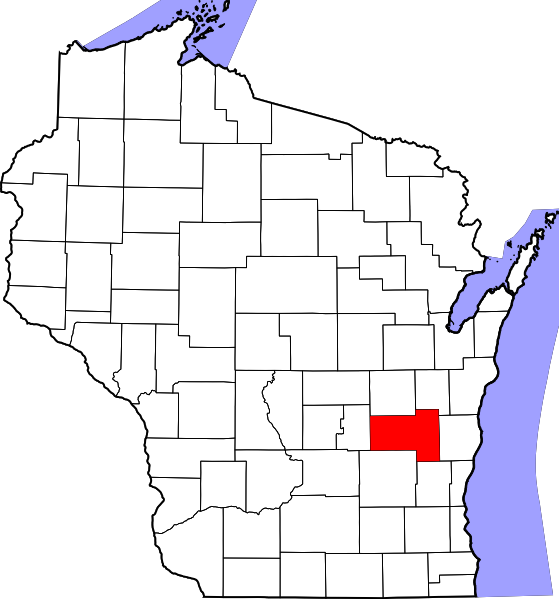
A Fond Du Lac Farmer has regrets about agreeing to host a wind turbine--
Why can't he speak openly about it?
When you sign a 20 to 30 year contract to host a wind turbine on your property you may be signing away many rights you're unaware of. A confidentiality agreement in the contract may mean legal action can be taken against you if you complain publicly about the project. A Fond Du Lac farmer signed away his rights. He was interviewed by Don Bangart who wrote the following on behalf of the farmer, whose contract with the wind company prevents him from speaking openly about any problems.
This was printed as a full page ad in the Chilton, Wisc., Times-Journal, October 25, 2007.
WHAT HAVE I DONE?
Now each morning when I awake, I pray and then ask myself, “What have I done?”
I am involved with the BlueSky/Greenfield wind turbine project in N.E. Fond du Lac County. I am also a successful farmer who cherishes his land. My father taught me how to farm, to be a steward of my fields, and by doing so, produce far better crop production. As I view this year’s crops, my eyes feast on a most bountiful supply of corn and soybeans. And then my eyes focus again on the trenches and road scars leading to the turbine foundations. What have I done?
In 2003, the wind energy company made their first contacts with us. A $2,000 “incentive” started the process of winning us over, a few of us at a time. The city salesmen would throw out their nets, like fishermen trawling for fish. Their incentive “gift” first lured some of us in. Then the salesmen would leave and let us talk with other farmers. When the corporate salesmen returned, there would be more of us ready to sign up; farmers had heard about the money to be made. Perhaps because we were successful farmers, we were the leaders and their best salesmen.
Sometime in 2004 or 2005, we signed $4,000 turbine contracts allowing them to “lease” our land for their needs. Our leases favored the company, but what did we know back then? Nobody knew what we were doing. Nobody realized all the changes that would occur, over which we would have no control. How often my friends and I have made that statement: What have I done?!
I watched stakes being driven in the fields and men using GPS monitors to place markers here and there. When the cats and graders started tearing 22-foot-wide roads into my fields, the physical changes started to impact not only me and my family, but, unfortunately, also my dear friends and neighbors. Later, a 4-foot-deep by 2-foot-wide trench was started diagonally across my field. A field already divided by their road was now being divided again by the cables running to a substation. It was now making one large field into 4 smaller irregularly shaped plots. Other turbine hosts also complained about their fields being subdivided or multiple cable trenches requiring more of their land. Roads were cut in using anywhere from 1,000 feet to over half a mile of land to connect the locations. We soon realized that the company places roads and trenches where they will benefit the company most, not the landowner. One neighbor’s access road is right next to some of his outbuildings. Another’s is right next to his fence line.
At a wind company dinner presented for the farmers hosting the turbines, we were repeatedly told — nicely and indirectly — to stay away from the company work sites once they start. I watched as my friends faces showed the same concern I had, but none of us spoke out. Months later, when I approached a crew putting in lines where they promised me they definitely would not go, a representative told me I could not be there. He insisted that I leave. The line went in. The company had the right. I had signed the lease.
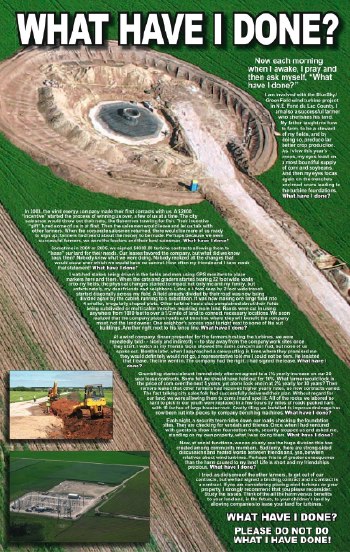 Grumbling started almost immediately after we agreed to 2% yearly increases on our 30-year lease contracts. Some felt we should have held out for 10%. What farmer would lock in the price of corn over the next 5 years, yet alone lock one in at 2% yearly for 30 years? Then rumors emerged that other farmers had received higher yearly rates, so now contracts varied. The fast-talking city sales folk had successfully delivered their plan. Without regard for our land, we were allowing them to come in and spoil it. All of the rocks we labored so hard to pick in our youth were replaced in a few hours by miles of roads packed hard with 10 inches of large breaker rock. Costly tiling that we installed to improve drainage had now been cut into pieces by company trenching machines.
Grumbling started almost immediately after we agreed to 2% yearly increases on our 30-year lease contracts. Some felt we should have held out for 10%. What farmer would lock in the price of corn over the next 5 years, yet alone lock one in at 2% yearly for 30 years? Then rumors emerged that other farmers had received higher yearly rates, so now contracts varied. The fast-talking city sales folk had successfully delivered their plan. Without regard for our land, we were allowing them to come in and spoil it. All of the rocks we labored so hard to pick in our youth were replaced in a few hours by miles of roads packed hard with 10 inches of large breaker rock. Costly tiling that we installed to improve drainage had now been cut into pieces by company trenching machines.
Each night, a security team rides down our roads checking the foundation sites. They are checking for vandals and thieves. Once, when I had ventured with guests to show them foundation work, security stopped us and asked me, standing on my own property, what I was doing there. What have I done?
Now, at social functions, we can clearly see the huge division this has created among community members. Suddenly, there are strong-sided discussions and heated words between friends and, yes, between relatives about wind turbines. Perhaps this is a greater consequence than the harm caused to my land — life is short, and friendships are precious.
I tried, as did some of the other farmers, to get out of our contracts, but we had signed a binding contract. If you are considering placing wind turbines on your property, I strongly recommend that you please reconsider. Study the issues. Think of all the harm to your land, and, in the future, to your children’s land, versus the benefits from allowing companies to lease your land for turbines.
WHAT HAVE I DONE?
PLEASE DO NOT DO WHAT I HAVE DONE!
The Ontario Federation of Agriculture offers these 30 suggestions for wind farm leases for farmers. Some of these are specific to Canada but they will give you an idea of the unexpected complications and the kinds of rights you may be signing away (click here to read it at its source)
From the ONTARIO FEDERATION of AGRICULTURE APRIL 2007
30 Suggestions on Wind Power Leases for Farmers
Ontario needs power and farmers need income. OFA favours wind power where generators do not harm
other things important to the community. If you sign a lease make sure it fits your plan for your farm.
1. Meet with your neighbours – Meet and work with your neighbours and OFA Services Rep.
2. Cost of a Lawyer - Ask the wind power company to pay to have the agreement reviewed by a
lawyer who will work for everyone in the area. This saves you $ 500 to $ 1,000.
3. Transferability - Add a clause that stipulates that the agreement cannot be transferred by the
wind company to any person or company without your approval.
4. Appearance – No leases address appearance, but you could have to look at it for 50 years.
Add a clause that prohibits advertising on the tower.
Add a clause that stipulates the paint colour be agreed and repainted if it becomes rusty.
Add a clause that covers effective reclamation of the site when all is done.
5. Building Restrictions – Attach a map of the property to the agreement that outlines areas
where new buildings over 20 metres can and cannot be built.
6. Fill Material - Under no circumstances should a developer use fill taken from your land.
7. Gear oil - You can use the lease to prohibit the use of toxic gear oil.
8. Option Termination - Add a clause that stipulates that the option ends at 5:00 p.m. on a
specific date if construction has not started by that date. You need a clear ending to the option.
9. Net Meter Tower - Ask the company to lend you its crane to install your own net metered
wind generator. You must be ready when they are, but it could save you $ 10,000.
10. Option - The minimum should be $ 5,000/ 100 acres for three to five years. No renewal; they
put up a wind tower or they are gone. No payment is enough to make a bad lease worthwhile.
11. Rent – Rent should be at 3% for the first eight years then go to 8% once bank loans etc. are
covered. Rent should apply to all income from the project including green house gas credits.
12. Insurance - Add a clause stipulating that the wind company must produce a valid certificate of
insurance covering liability to the farm and others each year and that it assumes full liability for
damage caused by the wind tower or the contractors or consultants etc..
13. Protect Capital Value - Add a clause requiring the wind power company to make whole any
losses in re-sale value that might occur as a result of the lease or a wind tower being in place. If
the wind tower effects your land value, losses might not be covered by rent.
14. 0ther Development – If the property may be valuable for other development in the next 30
years do not sign, you will be giving the wind company your future profits or capital gains.
15. Your Other Rights - Some leases have clauses that appropriate your development rights for
aggregates, ground water, top soil, sale outside of the family and even your right to speak in
public on wind power questions. Any such clause should be stricken from the agreement.
16. Tenants Rights - Stipulate that the only rights the tenant will have are the rights to do needed
studies, the rights to construct, operate and maintain no more than two wind towers per 100
acres as well as required roads and wires, and to remove the electricity from the site to the grid.
17. A Cooling Off Period – have a clause that states that either party may cancel the agreement
within 30 days without reason or penalty.
18. Power Sales - Stipulate that power must be sold to government or you get to approve any
other contract. Without this power can be sold to a subsidiary of the wind power company and
the 3% rent you were hoping for will 3% of very little.
19. Hours, Times of Access – Access for emergencies at any time. Other access between 8:00
a.m. and 5:00 p.m. Monday to Friday and requires notice so there is no interference with
seeding, harvests, calving, or other farm or family activities that are time restricted
20. Area of Lease - Limit the area covered by lease to a suitably small area – 1 to 5 acres
21. Applies to One Lot Only - Limit the agreement so it only applies to the actual lot leased and
that there is no reference to any other land owned by the farmer
22. Conversion to Easement – Do not allow a conversion to an easement as it will be more
difficult, perhaps impossible to discharge at the end.
23. Quitclaim – ensure the lease provides for a clean end so the wind company cannot be
released from the lease or recover funds from the escrow account without your approval and
certification that they have met all their obligations including clean up.
24. Wind Rights Only - Do not allow any clause that gives the wind power company a right of first
refusal or an option for any purpose other than the use of the wind. Such clauses encumber
sales, wills, development of other businesses etc.
25. Term of Lease – suggest 3 year option, 20 years for first term and 5 year renewals to follow.
This provides enough time to do tests and make profits and brings the replacement date for the
generator and the lease renewal dates closer together, which improves your negotiating position.
26. Assessment and Property Taxes – the land owner is ultimately responsible for taxes – a
clause to require the wind power company to pay taxes associated with the wind tower is
essential and it requires an enforcement clause – you cannot afford their taxes, unless you have
their income. In the case of default, you should get the licences to produce and sell power.
27. Escrow Fund – Require the tenant to have an escrow fund held with your lawyer or a trust
company. This fund will be established with the start of construction and used to pay any
arrears in taxes, any maintenance that the company refuses to do and will fund reclamation.
28 Registration of Surveys – surveys should only be registered with your approval and the
agreement should specify that the tenant does not acquire a legal right of way or any privilege
that could lead to shared or sole title. The tenant only acquires limited rights to use for a period,
but no easements or rights of way.
29. Wait ‘Til You Know Your Choices – The government has a Standard Offer. You can have
your own wind project or you can find other firms or partners. You may do better than you
might as a landlord. Don’t sign a lease until you have considered the choices and
determined what is best for your farm operation for the next 20 plus years.
30. If you wish to increase your bargaining power apply to Hydro One or your local
distribution company for the right to connect a generator yourself. The connection
agreement is valuable, acquire it for yourself.
(To read more about what you should know before you sign a contract, click here)
12/3/07 Why a Farmer in Johnsburg Wisconsin Regrets signing on for Turbines
Why A Wisconsin Farmer is Having Regrets
(Click Here to read this at its original source, the Appleton Post-Crescent, November 30, 2007, )
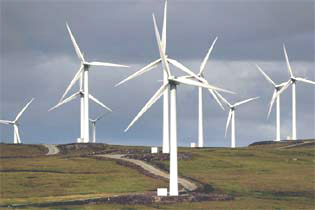
As told in a recent ad, a Johnsburg farmer who will host wind turbines now has many regrets.
He regrets having been the "lure" to draw in other unsuspecting landowners. He regrets that he has allowed fields to be subdivided, road base to be spread on land once picked bare of rocks, costly tiling to be cut up. He regrets that he's no longer the person who controls his own land and is now told where to go by security guards. He regrets the divide he has created between friends, between neighbors and between family members.
He regrets not having looked into all the ramifications first. That farmer is now locked in to a binding contract. But there are many landowners who have not yet suffered this fate.
Calumet County Citizens for Responsible Energy asks that landowners considering a contract first step back and study the issues. As with any financial transaction, don't put a lot of trust in those who stand to gain financially.
Look for Web sites and information from those experiencing the effects of this worldwide "gold" rush for wind power. People across world are rebelling. They're finding that they've lost control of their land and their lives. And they're in danger of financial hardship if these companies dissolve.
Our irresponsible government representatives are forcing this "windfall" for wind investors on us. Their knee-jerk reaction to the global climate change alarms will cause billions of dollars to be wasted, lives to be ruined, and environments degraded for what is, in actuality, a very inefficient energy source.
With a declining tax base and state and U.S. legislators driving us further into massive debt, taxpayer subsidies for wind will be impossible to maintain.
And with the subsidies gone, what will you be left hosting?
Don Bangert,
Chilton, Wisconsin
11/27/07 What Should You Know Before You Lease Your Land?
What should you know before you lease your land to a wind developer? You should know you must consult an independent lawyer BEFORE YOU SIGN. You will need someone who can tell you how the contract says the lease holder can use your land before, during and after construction.
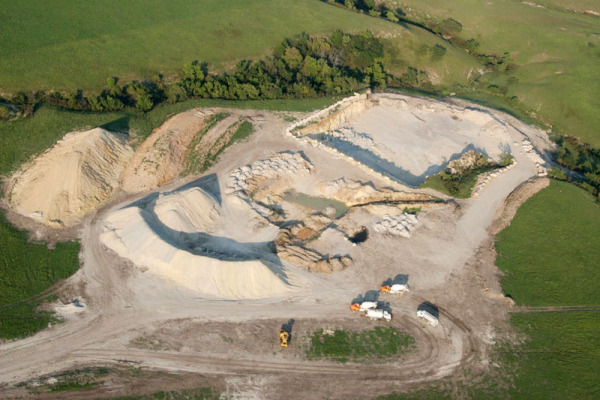
This picture shows the construction of a wind turbine project in Kansas.
Let's look closer..... 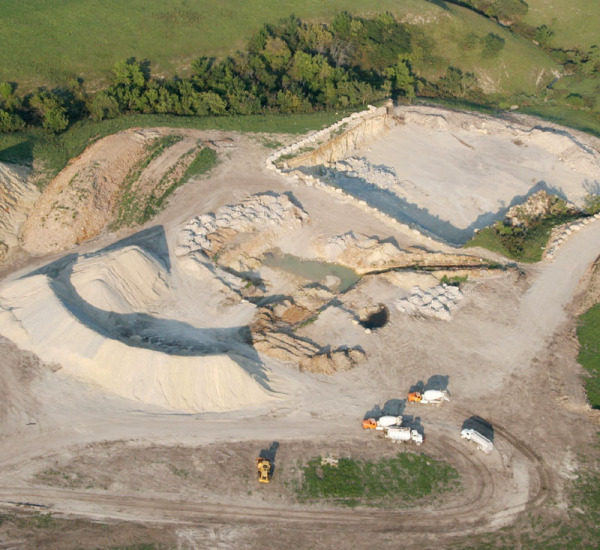
You should know how much of your land will be used during the construction phase and for how long, if you have any say at all in where the turbines will be sited, where the cables will be laid, and where the access roads will go. Only an independent lawyer can tell you what the contract says about this.
Look closer-
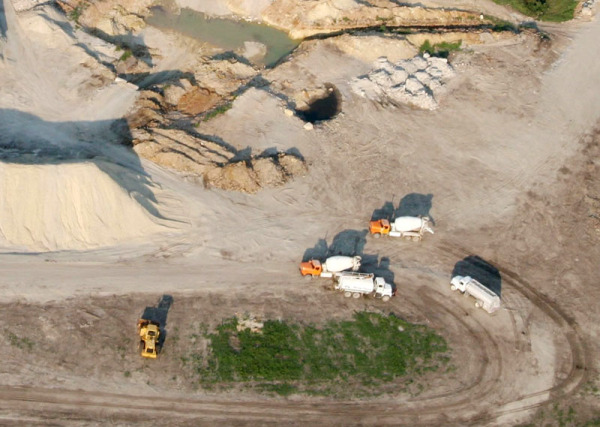
You should know that contracts may give the lease holder the right to go over, under, upon, along, and across your land, 24 hours a day, 7 days a week for the next 20 to 30 years. You should know what your rights are if changes, disputes or problems arise, and by what means problems may be resolved. An independent lawyer can tell you this.
Look closer..
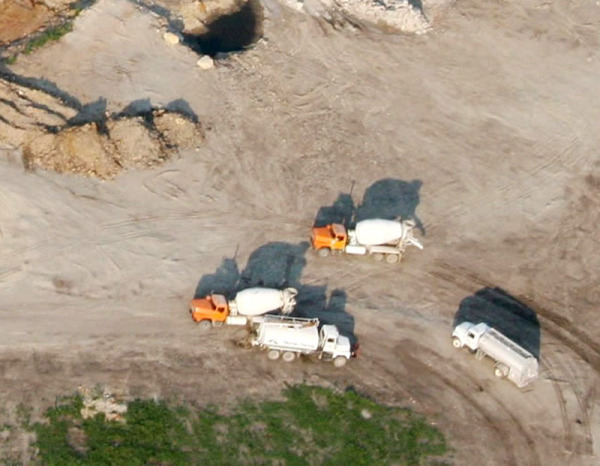
You should know that most lease agreements will be legally binding not just to you, but to your kids, any heirs, any future buyers, successors, executors, or assignees of any kind. You should know that most lease agreements require that ANYONE who owns the land after you or wishes to buy the land from you, will be also legally bound by the terms of this contract. Only an independent lawyer can tell you exactly what this means to the future of your property.

(To see more of this series of construction photos taken in Kansas, click here.)
